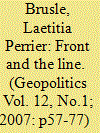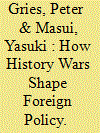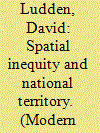| Srl | Item |
| 1 |
ID:
137843


|
|
|
|
|
| Summary/Abstract |
This article explores how geographical forms of Israel/Palestine are represented in maps sketched by high school students. The results show that they are significantly different from the geopolitical map, demonstrating the unique ways through which these students think about the national territory. The paper probes two sources that feed into the country's geographical image: its ongoing politics of treating boundaries as potential frontiers, and the school curriculum, which conveys a double message regarding borders. This image of a blurred geo-body invites for creative resolutions of the Israeli-Palestinian conflict.
|
|
|
|
|
|
|
|
|
|
|
|
|
|
|
|
| 2 |
ID:
076566


|
|
|
| 3 |
ID:
184755


|
|
|
|
|
| Summary/Abstract |
Do history wars shape international affairs? If so, how and for whom? Taking the historical dispute between China and South Korea over the ancient Gaogouli/Goguryeo Kingdom as a case study, this article explores the individual-level psychological micro-foundations of history wars. A 2020 survey experiment in South Korea pit “ours” vs “theirs” Goguryeo imitation Wikipedia entries to explore their downstream consequences. It revealed direct, indirect, and conditional effects. Exposure to China's claim to the Kingdom undermined Korean pride, increasing dislike of China, and lessening desires to cooperate with it. Pre-existing levels of nationalism divided South Koreans in how angry they became after exposure the Wikipedia primes. That anger, however, only shaped the China policy preferences of those South Koreans who viewed the balance of military power with China favorably. Implications for ownership disputes over kimchi and other national possessions are also discussed, as are the implications of history wars for war and peace in twenty-first-century East Asia.
|
|
|
|
|
|
|
|
|
|
|
|
|
|
|
|
| 4 |
ID:
146216


|
|
|
|
|
| Edition |
Enlarged 2nd ed.
|
| Publication |
New Delhi, Pentagon Press, 2016.
|
| Description |
xxv, 166p.hbk
|
| Standard Number |
9788182748620
|
|
|
|
|
|
|
|
|
|
|
|
Copies: C:1/I:0,R:0,Q:0
Circulation
| Accession# | Call# | Current Location | Status | Policy | Location |
| 058736 | 355.033054/DAS 058736 | Main | On Shelf | General | |
|
|
|
|
| 5 |
ID:
112478


|
|
|
|
|
| Publication |
2012.
|
| Summary/Abstract |
In 1905, Viceroy Nathaniel Curzon applied well-worn principles of imperial order to reorganize northeastern regions of British India, bringing the entire Meghna-Brahmaputra river basin into one new administrative territory: the province of Eastern Bengal and Assam. He thereby launched modern territorial politics in South Asia by provoking an expansive and ultimately victorious nationalist agitation to unify Bengal and protect India's territorial integrity. This movement and its economic programme (swadeshi) expressed Indian nationalist opposition to imperial inequity. It established a permanent spatial frame for Indian national thought. It also expressed and naturalized spatial inequity inside India, which was increasing at the time under economic globalization. Spatial inequities in the political economy of uneven development have animated territorial politics in South Asia ever since. A century later, another acceleration of globalization is again increasing spatial inequity, again destabilizing territorial order, as nationalists naturalize spatial inequity in national territory and conflicts erupt from the experience of living in disadvantaged places. Remapping 1905 in the long twentieth century which connects these two periods of globalization, spanning eras of empire and nation, reveals spatial dynamics of modernity concealed by national maps and brings to light a transnational history of spatial inequity shared by Bangladesh and Northeast India.
|
|
|
|
|
|
|
|
|
|
|
|
|
|
|
|